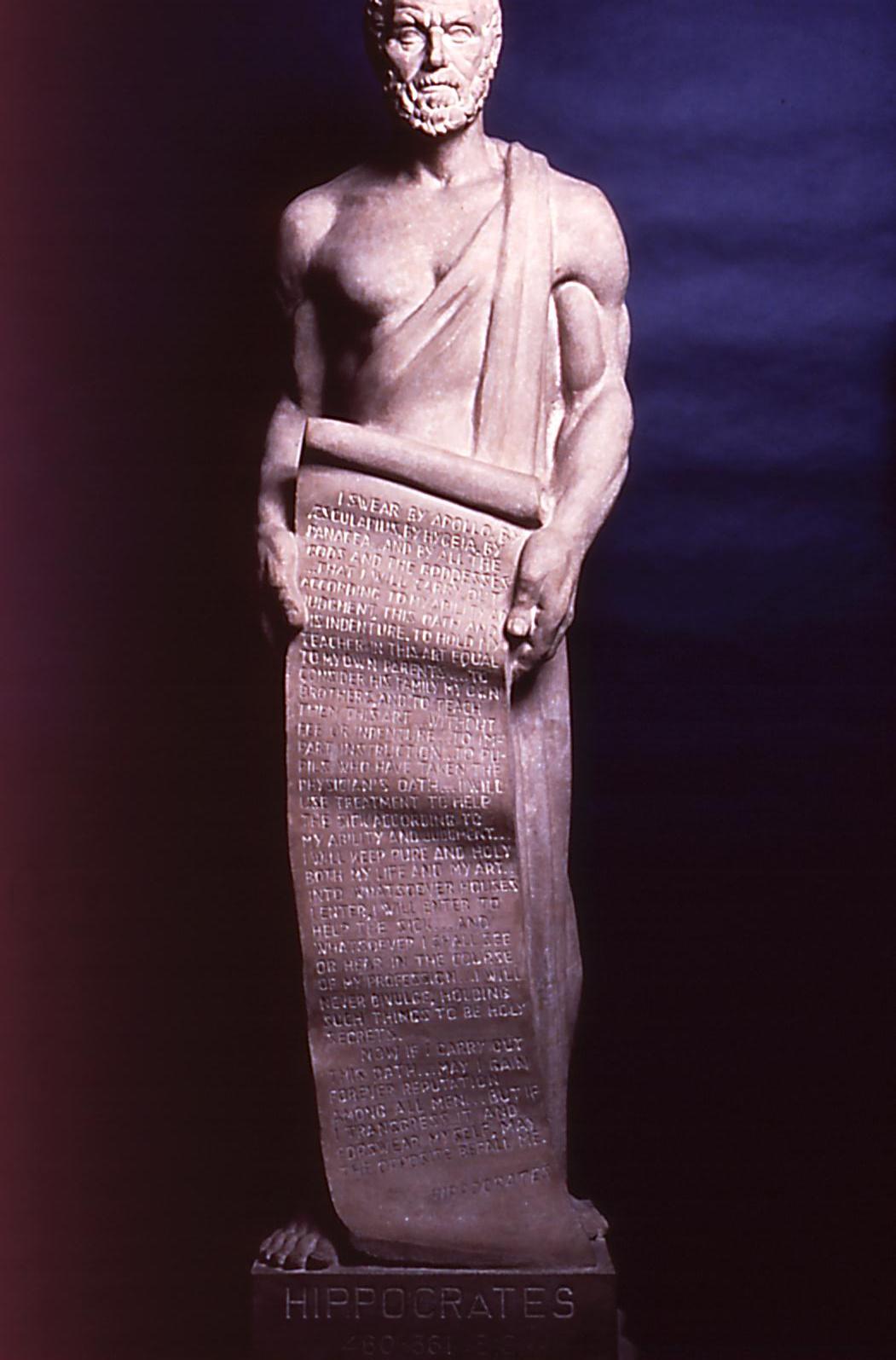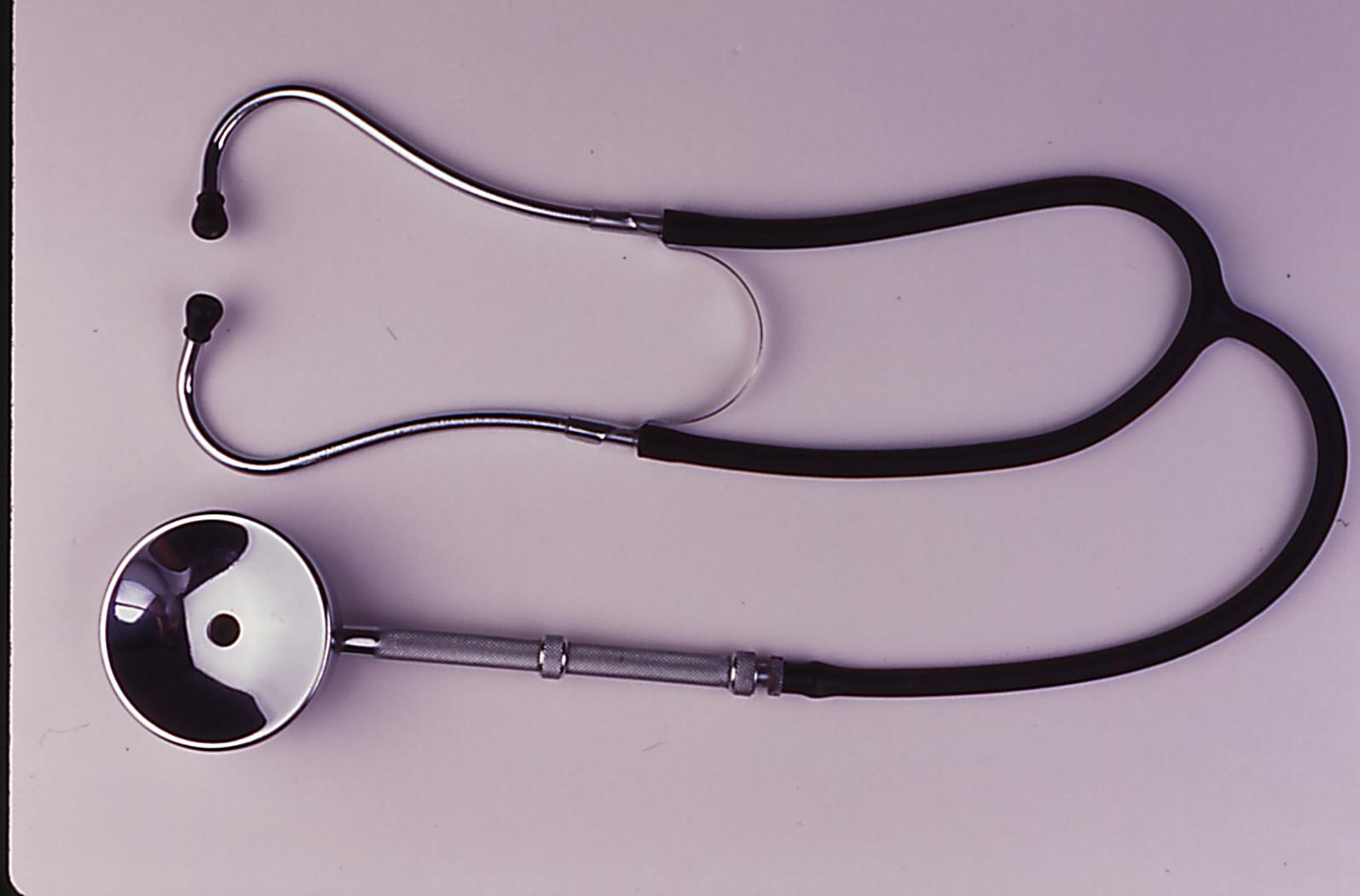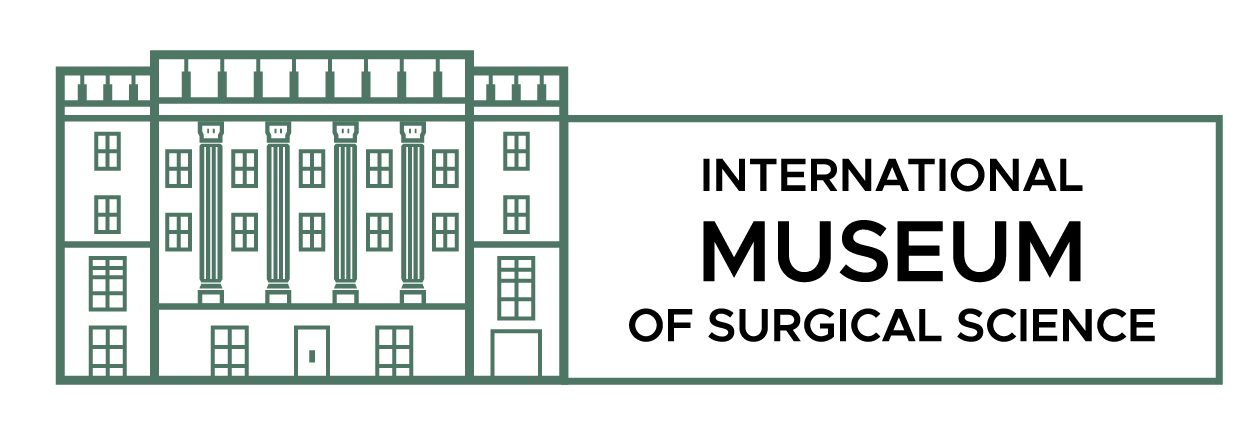Published by Annagh Devitt
First do no harm.
This maxim is tied to the medical profession, and is often falsely attributed to Hippocrates from his famous medical oath. However, despite its ubiquity, the phrase has no practical application for doctors today. The way this idiom has evolved over time, including its practicality in the surgical room, provides insights into how physicians approach their profession and perhaps more importantly, how they approach their relationships to their patients.

Cast stone sculpture of Hippocrates (460-361 BC) by Louis A. Linck. xx1995.460 International Museum of Surgical Science Collection.
Often misquoted from the Hippocratic Oath, this phrase might have originated from another Hippocratic work, Epidemics I, where he says that physicians “have two special objects in view with regard to disease, namely, to do good or to do no harm.”[1] On one hand, Hippocrates is emphasizing the limited ability of physicians at that time to heal patients. After all, the misguided notion of humorism, the belief that the balance of the four humors—blood, phlegm, black bile, and yellow bile—controlled one’s health began at this time. Quite literally then, if a physician could not “do good” in balancing the humors, then he would be offsetting the balance and theoretically causing harm.[2] On the other hand, this phrasing of “at least do no harm” provides an insight into how physicians approached their relationships with their patients. Far less noble than a want of good health for their patients, this phrase was a protective measure for physicians. For example, when Alexander the Great suffered a severe wound, no physician was willing to treat it for fear of being blamed for his death. Alexander the Great had to declare his condition untreatable before any physician would touch him.[3] The fear of being blamed for a prominent person’s death led to an early form of patient consent, which remains an ethical concern for physicians to this day.
The popularization of “first do no harm”[4] was through a medical ethics book by Worthington Hooker in another era afflicted with defensive medicine. However, instead of fear of death driving patient consent like in ancient Greece, doctors in the 19th century feared malpractice suits. The consent of this time and the doctor’s relationship to their patient was far more nuanced than it was in antiquity. While doctors in Greece put their own self-preservation above their patients, the doctors of 19th century ultimately sought the best of their patients. However, the means by which they tried to secure those outcomes would be considered unethical today. The majority of physicians at this time did not believe in revealing the extent of a patient’s illness to them. If they were to do so, many believed the patient would be frightened enough to refuse surgery or other life-saving practices. While in the best intentions, the physicians of this era refused autonomy for the patients and “obtain[ed] consent for [no] purpose other than a medically good outcome.”[5]
A series of legal battles in the 20th century ultimately changed this well-intentioned but harmful view towards patient consent. A malpractice case in the late 1950’s awarded nearly a quarter of a million dollars to a patient who was not informed properly of the risks of a medical procedure. The plaintiff, named Salgo, had cramping in his legs and went to Stanford hospital to get a further diagnostic. The doctors at Stanford decided to take x-rays of a calcium deposit they found in his descending aorta. However, the next morning Salgo was completely paralyzed from the waist down. The resulting legal case, Salgo v. Leland Stanford, determined that the primary doctor did not properly inform his patients of the possible side effects of the procedure.[6] This legal precedent enforced the notion of informed consent—that for patients to consent to a medical procedure they must be fully aware of other treatment options and possible negative outcomes of such treatments.

Much of the advances and nuances of patient consent were carried out on a legal stage for the majority of the 20th century. However, by the 1980’s, the medical profession started to look inward to grapple with the ethical dilemmas in the profession. The American Medical Association (AMA) recognized informed consent as “a basic social policy.”[7] From there, many of the more nuanced looks at patient consent have come from medical ethics and bioethics experts in the field. For example, there is a current debate on how a patient can consent autonomously. Some in the medical community argue that a joint decision should be made between patients and doctors regarding their treatment plans. However, other ethicists argue that assent to a recommended treatment is not approval and hence not autonomous. The shared-decision making argument echoes to the time of “first do no harm,” where doctors believed their patients to be too uninformed to make logical decisions. However, in light of today’s technology that might be a far better system. Because of the myriad of resources available to a patient, they can often be far more informed about their condition that at any other time. While this does come at a cost, primarily in the form of false information, it means the doctor and patient are on a much more level playing field. Obviously, a google search is not comparable to the years spent in medical school, however such access to information allows the patient to converse with the doctor and decide on the best course of action for themselves.
“First, do no harm” does not appear in any form in the oath most doctors take today. Instead, the oath emphasizes the patient; “I will respect the privacy of my patients…I will remember that I do not treat a fever chart, a cancerous growth, but a sick human being.”[8]
Notes & Bibliography:
- Shmerling, Robert H., “First, do no harm” Harvard Health Blog. October 14, 2015. https://www.health.harvard.edu/blog/first-do-no-harm-201510138421
- Cartwright, Mark, “Ancient Greek Medicine” Ancient History Encyclopedia. April 11, 2018. https://www.ancient.eu/Greek_Medicine/
- Kumar, Nandini K., “Informed consent: Past and Present” Perspectives in clinical research vol. 4,1. (2013): 21-5. https://www.ncbi.nlm.nih.gov/pmc/articles/PMC3601698/
- Beauchamp, Tom I., “Informed Consent: I. History of Informed Consent” Encyclopedia of Bioethics. Encyclopedia.com. 2004. https://www.encyclopedia.com/science/encyclopedias-almanacs-transcripts-and-maps/informed-consent-i-history-informed-consent
- Beauchamp, Tom I., “Informed Consent: I. History of Informed Consent” Encyclopedia of Bioethics. Encyclopedia.com. 2004. https://www.encyclopedia.com/science/encyclopedias-almanacs-transcripts-and-maps/informed-consent-i-history-informed-consent
- Salgo v. Leland Stanford etc. Bd. Trustees” Justia. https://law.justia.com/cases/california/court-of-appeal/2d/154/560.html
- Riddick, Frank A., “The Code of Medical Ethics of the American Medical Association” Ochsner Journal. Vol. 5,2 (2003): 6-10. https://www.ncbi.nlm.nih.gov/pmc/articles/PMC3399321/
- Tyson, Peter. “The Hippocratic Oath Today” NOVA. March 26, 2001. https://www.pbs.org/wgbh/nova/article/hippocratic-oath-today/
Webster, Lynn, “The Tribune was wrong. Medicine often involves a risk to the patient.” Dr Lynn Webster. December 9, 2017. http://www.lynnwebstermd.com/first-do-no-harm/
Keckley, Paul, “The Decline and Fall of the Doctor-Patient Relationship” The Health Care Blog. September 9, 2017. http://thehealthcareblog.com/blog/2017/09/09/the-decline-and-fall-of-the-doctor-patient-relationship/
Annagh Devitt is the current Education Intern at the International Museum of Surgical Science. She is a student studying chemistry at the University of Chicago. Her interests include the history of medicine, in particular how ethics in medicine has developed throughout history.


